Peter MALONE
Saturday, 18 September 2021 19:53
Playmates/ 1941
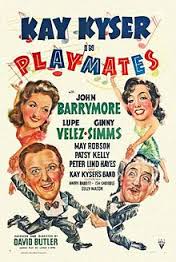
PLAYMATES
US, 1941, 96 minutes, Black and white.
Kay Kyser, John Barrymore, Lupe Velez, Jinnie Sims, May Robeson, Patsy Kelly, Peter Lind Hayes.
Directed by David Butler.
This is film which contemporary audiences will not much appreciate, even thinking it rather silly (which it is). It is a film for cinema historians and film buffs. This is principally because it is the last film of the celebrated stage and screen actor, John Barrymore, from the famous Barrymore family, sister Ethel, brother Lionel, daughter Diana, granddaughter Drew.
The film has a basically stupid idea – that John Barrymore should coach bandleader Kay Kyser as a Shakespearean actor. The motivation of the publicists of each of the stars is that they will get their names in the papers, no matter what, and Barrymore will get a radio advertising contract and Kyser a broad audience. The basic story came from James V. Kern, writer of a number of films of the 1950s but more prolific as a television director.
Kay Kyser was popular in the 1940s as a bandleader and appeared in a number of films. As he appears in this film, he is a genial enough personality, more at home directing his band, though he has a number of comic moments here.
John Barrymore had had a celebrated career but declined into parody of himself, having his famous profile and expressions, especially eyes rolling and raised eyebrows, which are very evident in this film. He also had severe alcohol problem and died after this film from cirrhosis of the liver. To that extent, the oddball plot resembles something of his own personal career. He died at the age of 60. So, this is an opportunity to see Barrymore and, despite the constant mugging, to hear him recite some passages of Shakespeare, especially Hamlet’s To Be or Not To Be soliloquy.
The film offers opportunities for contemporary songs, especially from Jinnnie Simms, very popular during the 1940s, also appearing in some films.
In the supporting cast are Patsy Kelly as Barrymore’s gung-ho assistant and Peter Lind Hayes as Kyser’s enthusiastic manager. There is a pleasing support performance by veteran May Robson, in her 80s at this time, as Kyser’s grandmother, all bark but with little bite and charmed by Barrymore. As well, there is a lively performance, and rumba, from Lupe Velez.
Director David Butler had been working in film since the 1920s, many routine films in the 1930s and into the 1940s but success at Warner Brothers in the late 1940s, early 50s, including six Doris Day musicals and Lullaby of Broadway, Tea for Two, calamity Jane.
So this is what RKO was doing at the beginning of the 1940s – and sad postscript to the life and career of John Barrymore.
Published in Movie Reviews
Published in
Movie Reviews
Tagged under
Saturday, 18 September 2021 19:53
Kissing Jessica Stein
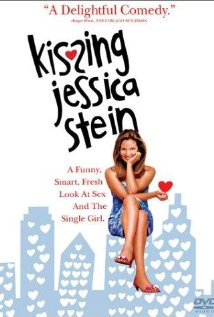
KISSING JESSICA STEIN
US, 2001, 97 minutes, Colour.
Jennifer Westfeldt, Heather Juergensen, Tovah Feldshuh, David Aaron Baker, Scott Cowan.
Directed by Jennifer Westfeldt.
Kissing Jessica Stone was a strong commercial success in 2001. It is a romantic comedy, co-written with Heather Jurgensen and the star, Jennifer Westfeldt (who also made the film Friends with Kids).
Jessica Stein is a 30 something copy editor with a good job, and an aspiring artist, in a relationship with her college boyfriend who is also her boss at the office, Josh. There is tension in the relationship from both sides. In this context, Jessica encounters an art gallery director, Helen, Heather Jurgensen. There is a mutual attraction, Helen overt in her expressions of affection, but gradually falling in love and beginning and affair.
In the background is Jessica’s Jewish family, especially her eager but overbearing mother. Mother is easier to see Jessica engaged, married, pregnant.
The film also shows life in the office with the various people putting pressure on Jessica and wanting to know what is happening with her relationships.
The screenplay does not go in the direction anticipated, with Jessica fearful of revealing her orientation, Helen becoming exasperated and the two separating – finally meeting at the end as friends.
1. A romantic comedy with a difference? Thirtysomethings? Heterosexual relationships? Lesbian relationships?
2. The settings in New York City, Connecticut? Offices, apartments, homes, restaurants and the social world? The wider situation of large families? The musical score?
3. The Jewish perspective, adults, belief or not, rituals, the rabbi, the mother and her wanting to arrange marriages? The stereotypical Jewish mother?
4. Jessica Stein, her life, work, wanting to be an artist, her relationship with Josh, personal, the past in College, her boss? The discussions in the office, the gossip, the pressures?
5. Jessica and her orientation, the beginning of feelings of attraction to women? The encounter with Helen, the art gallery, Jessica’s art, the outings, falling in love? The experiences? The effect? Helen at the Stein family dinner?
6. Helen as a strong character, openly gay, Jessica and her covering the relationship, reactions, the dinner, Helen and the cooling of the relationship? The separation? The later meeting as friends?
7. Josh, from college, the boss at work, and aspiring writer? Life with Jessica? Time away? Josh and his trying to sort himself out, emotionally?
8. Jessica’s mother, interfering, the dinner, hosting, suspicions, extroverted? The initial sequences with grandma and the stereotypical Jewish grandma?
9. The workplace, friends, confidence, the pregnant friend, her husband, at the socials, wanting to know what was happening?
10. New York, social life, affluence and style?
11. Jessica, her experience, her age, sexuality, her future?
12. The film and its GLAAD awards for portrayal of gay issues, 2001?
Published in Movie Reviews
Published in
Movie Reviews
Tagged under
Saturday, 18 September 2021 19:53
Someone Marry Barry
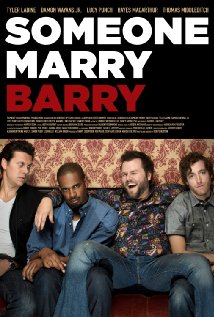
SOMEONE MARRY BARRY
US, 2012, 85 minutes, Colour.
Tyler Labine, Damon Wayans Jr, Lucy Punch, Hayes Mac Arthur, Thomas Middleditch Ed Helms.
Directed by Rob Pearlstein.
Someone Marry Barry is a kind of dumb and dumber romantic comedy – with plenty of rude and crass moments and dialogue, which audiences may be able to accept because of interest in the central characters – despite there being dumb and dumber.
This is the story of three friends who have a history together, meet regularly, and try to help their friend Barry (Tyler Labine). Barry is completely socially inept, says whatever comes into his head, makes the worse judgements, and gets involved in all kinds of slapstick situations. The three friends are becoming exasperated but decided that the best way out is to find a wife for Barry.
The three friends, including Damon Wayans Jr, try out all kinds of possible brides but none of them are suitable, or are above this kind of plotting and a fate with Barry.
Suddenly, on to the scene comes Melanie Miller. She is played by British actress Lucy Punch (one of the ugly sisters in Into the Woods). She is a female version of Barry and for laughs the film depends a lot on the scenes with the two together, mirroring each other, saying the most inappropriate things, sexual inuendo, and a raucous enjoyment of each other’s company.
When things begin to go wrong, the couple seem to be on the verge of breaking up, they are brought together, have heartfelt talks, understand each other, and, despite everything, the screenplay makes us presume that there could be happy ever after.
For those who can find the rude and offensive material comparatively inoffensive, this is an offbeat, odd couple, odd-romantic comedy.
Published in Movie Reviews
Published in
Movie Reviews
Tagged under
Saturday, 18 September 2021 19:53
New Faces of 1937

NEW FACES OF 1937
US, 1937, 100 minutes, Black and white.
Joe Penner, Milton Berle, Harry Parke (as Parkyakarkus) Harriet Hillyard, Jerome Cowan.
Directed by Leigh Jason.
This is a pleasant, if sometimes rather antique, comedy from RKO in 1937. It was a star vehicle for Joe Penner, who assumed a bumbling kind of character on-screen. It is also a star vehicle for Harry Parke, who went under the stage name of Parkyakarkus; his specialty was comedy, but especially routines playing on words. These two stars can be seen in typical roles in the 1939 Life of the Party.
Also in Life of the Party was comedian Milton Berle, years before he became a television personality and one of the most famous TV icons as Uncle Milty. One of his specialisations was playing the conman type, full of smart talk, shrewd, twisting situations to his an advantage.
Also in the cast of Life of the Party was Harriet Hillyard, the singer, who later married Ozzie Nelson and as part of televisions Harriet and Ozzie and their sons, Rick and David.
The main point. This film has a significant similarity to Mel Brooks’ The Produces, 30 years before that film came out. The basic idea is for a producer to put on a play, make it run at a loss rather than at a profit – which does not always pan out. This time the producer is crooked but gets out, and the other stars decide that the show must go on.
However, for historical reasons, the film is of interest in the careers of the stars – but, especially, with the overtones of The Producers.
Published in Movie Reviews
Published in
Movie Reviews
Tagged under
Saturday, 18 September 2021 19:53
Big Picture, The/ L'homme qui voulait vivre sa vie

THE BIG PICTURE/ L'HOMME QUI VOULAIT VIVRE SA VIE
France, 2010, 140 minutes, Colour.
Romain Duris, Marina Fois, Niles Arrestrup, Catherine Deneuve, Branka Katic, Eric Ruf.
Directed by Eric Lartigau.
The Big Picture is an entertaining French drama with a high-powered cast. Romain Duris has become one of the mainstays of the French film industry, here portraying a man working in a law firm, suspicious of his wife having affair, not wanting to be a father, not wanting to work in the law. Catherine Deneuve is his partner in the law firm.
Paul suspects his wife is having an affair with a photographer and, when she leaves, fights Gregoire because it is true. Paul has envied the life of the photographer, and in a scuffle, kills him, taking his money, taking the body are to sea, throwing it out and burning the yacht that he has taken.
When he tells his wife that is going to Hungary on business, he instead goes to Montenegro, assuming the photographer’s identity and name, becoming a success as a photographer himself, only to find that a pushy editor makes him a star, an exhibition and acclaim.
When Paul realises that he is getting too much exposure, he sails to Italy, encounters a stowaway who takes his photos of the pirates who attacked the boat. The question at the end of the film is what will Paul do now, new identity, further escapes?
1. A French drama, French style? Melodrama, fantasy?
2. The French locations, home, office, the sea, the escape? Exotic locations in Montenegro? Italy? The musical score?
3. The strong cast, their careers?
4. Paul’s story, working in the law firm, his relationship with Sarah, as a father, his wealth? His being the hero of his story, but presented as edgy, suspicious? His wife and the affair, the separation, finding out the affair was happening? The picture of marriage, infidelity? The business world? Paul and his working with Anne, her talking about her death, offering him her shares in the business?
5. Gregoire and Sarah, the affair, Paul envying Gregoire, his career, photographer? Paul and his suspicions, the fight, Gregoire’s death? Paul taking care of disposing of the body, taking Paul’s money, going to sea, the body overboard, his taking the yacht and burning it? His lies to Sarah about going to Hungary business?
6. Paul and his interest in photography, developing it, taking on Gregoire’s identity in Montenegro, a new life, a career? Bartheleme and his visit, somewhat overbearing, his interest in the photography, his work as an editor, promoting Paul, arranging the exhibition? Paul and the attraction to Ivana, the pictures editor?
7. Paul feeling that he was becoming too public, escaping, burning the car, at sea, the stowaway, the pirates, his taking pictures of the pirates, the stowaway taking them, their arrival in Italy, seeing the stowaway promoting the pictures?
8. Paul watching, smiling, walking away – what different future, what escapes?
Published in Movie Reviews
Published in
Movie Reviews
Tagged under
Saturday, 18 September 2021 19:53
Great Buck Howard, The
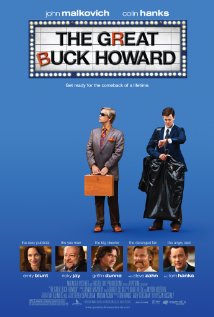
THE GREAT BUCK HOWARD
US, 2008, 90 minutes,. Colour.
John Malkovich, Colin Hanks, Emily Blunt, Ricky Jay, Steve Zahn, Tom Hanks, Griffin Dunne, Debra Monk, Adam Scott.
Directed by Sean Mc Ginly.
The Great Buck Howard is quite an entertaining film, often quite funny, with touches of pathos.
John Malkovich gives one of his excellent performances as the eccentric Buck Howard, an illusionist who was famous in his heyday but is now travelling small American towns, performing one night stands in theatres with small audiences – who nevertheless appreciate his act, songs, praise of the town, illusions, especially identifying where money is hidden (otherwise he would donote the money).Buck has had fame in the past, especially with his many appearances on the Johnny Carson show, but now, Jay Leno will not have him – and is blamed for Buck’s lack of success.
Colin Hanks is the young aspiring writer, forced to do Law at college by his father (played by Tom Hanks in two scenes). Answering an advertisement, he is hired by Buck after other assistants whom he humiliates and makes unreasonable demands of, are fired. Troy is fascinated, is humiliated himself, but is attracted to a publicity agent from New York who does not understand Buck, is exasperated by him, but is attracted to Troy.
The film is a reminder of vaudeville days, of the passing of that kind of entertainment in the modern era, and the performers being stranded unless they can get television appearances.
Debra Monk and Steve Zahn are fans in Cincinnati, and dominating, she introducing show, he being a starry-eyed had fan, to the great annoyance of Buck.
Even despite Buck, the film has a sweetness about it and is enjoyable.
1. An offbeat story, an eccentric central character?
2. On the American roads, in the small American towns, the mid-West, memories of Las Vegas, the theatres, the audiences, performances, Buck and his entourage?
3. Troy, law student, not wanting to study law, the pressure from his father, giving up his studies, answering the advertisement, wanting to write, arriving at the theatre, seeing Buck, seeing the various assistants and the way that they were treated, yet his signing on? His father later visiting him and questioning his choices?
4. The audience’s initial encounter with Buck, through Troy? The first impressions, John Malkovich’s presence, his appearance, manner, way of speaking? An entertainer, and illusionist, egotistic? Questions of his sexual orientation? His performance, the praise of the town, the songs, the magic, the routines?
5. The experience of his helpers, their reason for being with Buck, Buck condescending to them, humiliating them, firing them, his erratic demands, his eccentricity?
6. Troy, accepting employment, learning from the others, the different jobs, organisation, meeting people, the response to the demands, his being insulted and belittled?
7. The interview, the interviewer, the eventual publication, the belittling of Buck?
8. Buck and his ideas, the publicity woman coming from New York, her not wanting to be there, the touch of hardness, her reactions to Buck? Meeting Troy, discussions, Buck and his erratic behaviour, her trying to cope, admiring Troy, the liaison?
9. The key performance, offering to give his money away if the hiding place was found? The background to the routine, the questions about it, plant,
arrangement, the mystery?
10. The travel, the arrangements, the different towns, the theatres, the small audiences, the experience of the pushy woman and her admiring son, taking over, speaking at the beginning of the performance, Buck wanting to get rid of her? The son, his adulation, irritating Buck?
11. Buck giving interviews, his pomposity, his reminders of his appearances on the Johnny Carson show, his blaming Jay Leno for not having him on, for harming his career?
12. The result for Buck, the humiliation, the entrepreneurs and the backers, his collapse, hospital?
13. His trying to make a comeback, Troy and his leaving him, Troy and his writing, and with Valerie?
14. Troy tracking Buck down, for a final performance, and the failure of his trick with the money?
15. The film as a combination of comic, funny, with pathos, eccentricity, and the fascination of an odd central character?
Published in Movie Reviews
Published in
Movie Reviews
Tagged under
Saturday, 18 September 2021 19:53
Khumba
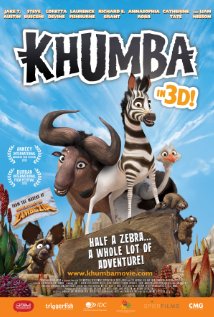
KHUMBA
South Africa, 2013, 85 minutes, Colour.
Voices of: Jake T. Austin, Steve Buscemi, Loretta Devine, Laurence Fishburne, Richard E Grant, Anika Noni Rose, Anna Sophia Rob, Catherine Tate, Liam Neeson.
Directed by Anthony Silverston.
This is a film for younger children, an animal film, a message film. In some ways, it is reminiscent of The Lion King and of the Ice Age films. However, this is the story of a half-striped zebra.
As the film do not have a big budget, made in South Africa, the animation style is less striking than many other films. It made up for this with the voice-cast, very strong, especially with Liam Neeson as the villain. But there are quite a number of comic characters as well is a serious characters, and Jake T. Austin is the voice of the half zebra.
The film establishes the range of animals, many of the popular animals from southern Africa. When Khumba is born, and everybody reacts to his lack of stripes, even his father who blames him for the drought and the death of his mother, there is nothing else to do but for Kuimbha to go off by himself, despite the dangers.
When he leaves, he goes into the territory of the villainous leopard, Phango, controlling the water, terrorising all the animals but who has a sad personal history of injury and coping. Khumba is rescued from a wild dog by a wildebeest and an ostrich, providing comic touches!
Mama V befriends him and is a different kind of mother, a wildebeest, unconventional, who cares for a somewhat over-the-top ostrich.
Khumba has a vision of a mantis, and draws a map to what could be a kind of promised land through the desert. He comes into his own, gaining itself confidence and maturity
Adult audiences with their children may find this a bit hard to sit through at times, but the children will respond to the animation, the characters and the adventures and the message of gaining self-confidence.
Published in Movie Reviews
Published in
Movie Reviews
Tagged under
Saturday, 18 September 2021 19:53
Plush
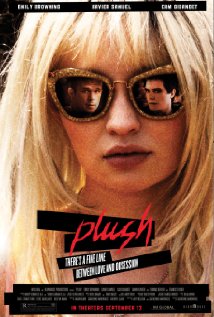
PLUSH
US, 2013, 99 minutes, Colour.
Emily Browning, Xavier Samuel, Cam Gigandet, Dawn Olivieri, Thomas Dekker, Frances Fisher, Elizabeth Pena,
Directed by Catherine Hardwicke.
What was Catherine Hardwicke thinking when she decided to write this screenplay and to direct the film? She had made her reputation as a film designer and then moved into direction, especially with Thirteen. She made quite a mark with the contrasting films The Nativity Story and the first of the Twilight films.
This is the story of a young woman who fronts a band, is disturbed by the overdose death of her brother, takes refuge in her marriage and her two children, but is quite insecure. A young man approaches to join the band, resembles her brother, is successful in performance, but comes onto her, seducing her, and causing great conflict – especially when it is revealed that he is mentally disturbed, an obsessive stalker, helped by his mother who becomes the housekeeper to the family.
So, a transition from the music world to the horror stalker world. Emily Browning is the singer, Thomas Dekker her brother, Cam Gigandet her husband and in the sinister role of the musician, Enzo, Xavier Samuel.
1. The title? Hayley? The band?
2. The world of bands and concerts, onstage, backstage, the group, musicians, singers? The contrast with ordinary suburban life?
3. The quality of the music, the music world, the songs, performance, audiences?
4. Hayley, her age, character, married to Carter, two children? Her close relationship with her brother? His overdose death? Her taking it badly?
5. Hayley, the concerts, the persona, with the band, singing? A lack of self-confidence? Brooding on her brother? Enzo, his resemblance to her brother, his initial impression, joining the band, his performance? His coming on to her? Sexual aura, dressed in black, eyeliner? Attractive and sinister? The complications, Hayley and a double life, leaving her family to meet Enzo? The effect?
6. Her brother, his persona, overdose, death, the close love, the effect on the Hayley, songs, trying to write songs, lyrics, and memories of her brother?
7. Enzo, in himself, the charm, appearance, playing, resemblance to Hayley’s brother, his advances, her response, the effect?
8. The doctor, the discussions with Hayley? Effect?
9. The housekeeper, Enzo’s mother, a presence in the house, the control, her defence of her son, going berserk?
10. Hayley, visiting Enzo, the deceptions? His stalking her, presence in the house, wanting complete control, her fears, the attack on Carter, the effect on the children? The ultimate confrontation and violence?
Published in Movie Reviews
Published in
Movie Reviews
Tagged under
Saturday, 18 September 2021 19:53
Finding Vivian Maier
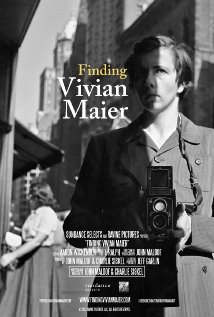
FINDING VIVIAN MAIER
US, 2014, 83 minutes, Colour.
Directed by John Maloof, Charlie Siskel.
This is very interesting film-making, nominated for and winning many awards. It is also intriguing.
Vivien Maier was a photographer, amateur, proud of her work even though she did not develop many of her negatives. She did work as a nanny in New York City and two of her charges were able to transfer her into a home for the elderly where she died in 2009.
John Maloof was searching, in 2007, for photographs to illustrate his book on the local area in Chicago. He bought Vivian Myers photographs at an auction but did not do anything about the photos, not even using them for the book, until he developed an interest in photography himself and went back to the cache, examining them, being impressed by them, and put about 100 online asking for people’s response.
Later, an exhibition was organised and Kickstarter was used to raise money for this documentary which Maloof himself co-directed with Charlie Siskel.
The film offers audiences a great number of Vivian Maier’s photographs, most taken in New York City, with a small camera at her waist, snapping ordinary characters, unusual characters, many on the margins of society. To this extent, the documentary is most impressive in its presentation of the photos and life in New York City.
However, the film also is a kind of investigation of the life of Vivian Maier, trying to track down records, some of which lead to friends and interesting stories about her background. It emerges that her work as a nanny with many families over many decades. The remaining talking heads, especially of those who were in her charge, contribute to a range of memories, mostly admiring, some expressing some old stories about her.
She herself emerges from some photos and some movie clips, a tall woman, smartly but rather severely dressed, photographing great number of subjects as well as herself. With the mystery of her name, differences about her birthplace, some suspecting French accented English, she becomes a mystery character, a number indicating that perhaps she suffered from some mental illnesses.
The BBC produced a documentary on her, The Vivian Maier Mystery, some months before the release of this film. Commentators note that it is more objective than the present documentary, especially because John Maloof himself produced and co-directed the film as well is being front camera and explaining his search. Nevertheless, what he has done has been of service to Vivian Maier, letting the world know her photographs, presenting so many of them on screen, as well as raising questions about the photographer herself which later investigators can develop.
Published in Movie Reviews
Published in
Movie Reviews
Tagged under
Saturday, 18 September 2021 19:53
Not Quite Hollywood
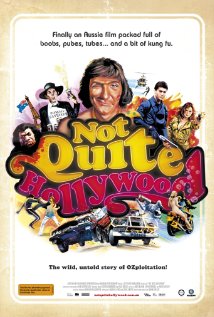
NOT QUITE HOLLYWOOD: THE WILD UNTOLD STORY OF OZPLOITATION!
Australia, 2009, 103 minutes, Colour.
Directed by Mark Hartley.
This is an intriguing documentary for anyone interested in the Australian film industry. But, it is not an analysis of mainstream Australian filmmaking. Rather, it is an exploration of the exploitation films, especially in the 1970s and into the 1980s, what has come to be Ozploitation.
It presents itself with several chapter headings, focusing, especially, on sexual themes as well as horror themes. The film tantalises its audience in the first chapters by focusing on sex. We are reminded of the Alvin Purple films, the exploitation films of John Lamond. As with the succeeding chapters, there is an ample selection of clips from many of the films. There are also many talking heads, producers, actors, directors and social observers.
During the 1970s a great number of horror films were produced. Many of them were made by Antony I. Ginnaen, reviled by many as an exploiter (especially by Bob Ellis and Phillip Adams during this film), making contracts with overseas stars to come to Australia, films which were considered mid-Pacific, angering the screen unions. A number of prominent directors made some of these films including Richard Franklin and Simon Wincer. Once again, there are many clips from these films, including Richard Franklin’s Patrick, which was later re-made by director, Mark Hartley.
The film takes back to the early 1970s with Tim Burstal’s Stork, with words from playwright, David Williamson. The Barry McKenzie? stories also feature with Dame Edna Everage and comments from Barry Crocker and Bruce Beresford. Interesting scenes from the making of Mad Dog Morgan, with the bizarre behaviour of the star, Dennis Hopper, and comments from producer Jeremy Thomas and director Philippe Laura. There are the martial arts actioners, even with comment from George Lazenby reflecting on his career. And the bikie film, Stone, with its star and director, Sandy Harbutt.
Another interesting feature of the film is that one of the major talking heads is Quentin Tarantino, drawing on his early experience, working in a video store watching all the horror films he could, which influenced his unique style. Tarantino must love Australia because he cast himself as an Australian (with an atrocious accent) in his Django Unchained.
Among the many talking heads are Alan Hopgood, Norman Yemm, producer Alan Finney, Graeme Blundell (Alvin Purple), producer David Hannay, John- Michael Howson, Stacy Keech and Jamie Lee Curtis reflecting on Road Games, George Miller on mad Max, Rod Taylor, Directors John Lamont, Ted Kotcheff (Wake in Fright) photographers Donald Mc Alpine, Russell Boyd and Vincent Monton top, Russell Mulcahy, Fred Schepisi, Sigrid Thornton and, amongst the contemporary directors with a flair for horror, Jamie Blanks, Wolf Creek’s Greg Mc Lean, and the Saw series James Wong and Leigh Whannell.
This is an opportunity to revisit the period, learn about some of the films, about people associated with them reflecting on the films, and, of course, see many of the clips.
Published in Movie Reviews
Published in
Movie Reviews
Tagged under